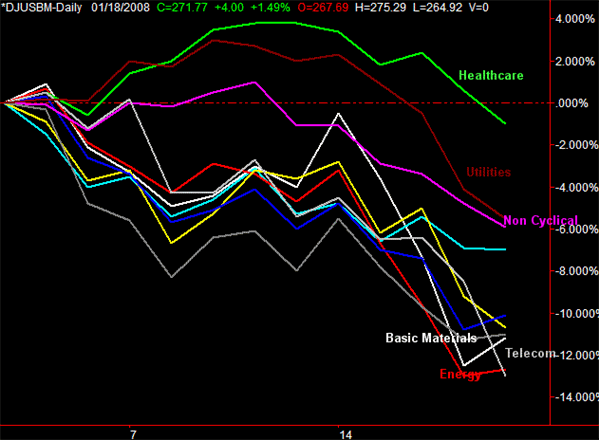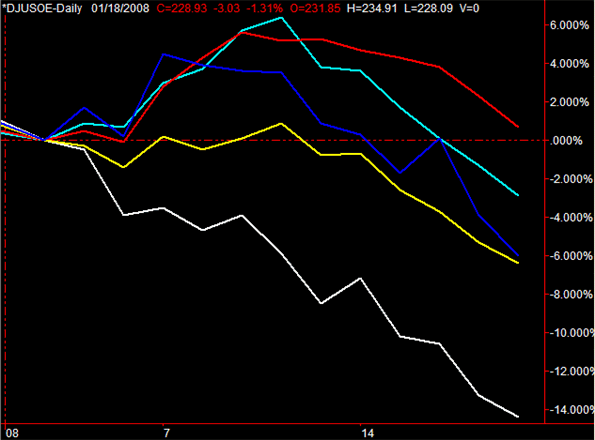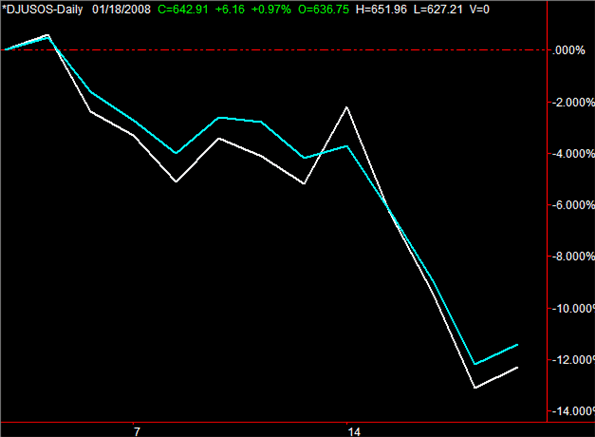So far the market's undertone this year is negative and more recently, it's panicked with global recession worries. There is no better time to stop and take a step backwards to find what parts of the economy are moving and in what direction. We've found over years of research that a more effective trading plan can be implemented if a broader approach is taken first. More specifically, let's take a look at the major economic sectors and their performance year to date. With 73% of trading days in 2008 ending negative it should be no surprise that all 10 major sectors are negative for the year.
Economic Sectors - Daily % Change YTD 2008

As we head into uncharted territory, investors are concerned with the possibility of a looming recession. The sector analysis shows this fear. As a defensive play investors are pouring capital into healthcare stocks as they hear the sound of a potential bear market and for good reason. Historically, the healthcare sector has out performed the market during recessions. Within the Healthcare sector, the Pharmaceutical industry has performed the best with more than 3% gain thus far.
Healthcare - Daily % Change YTD 2008

The utilities sector is the second best performer year to date with a loss of 4.75%. The stability of utility revenue is providing shelter for this sector and enticing investors as growth stocks lose their luster. Finally, the Non-Cyclical sector, which includes food and beverage, personal/ household products, tobacco and livestock, completes our top three round-up. Tabacco companies (red line) are clearly the best performer in the Non-Cyclical sector with amost a 1% gain this year. There is no surprise here as all three top performing sectors are historically good performers in bear markets and it seems that investors are putting up their guard by investing in these defensive sectors.
US - Non Cyclical - Daily % Change YTD 2008

Broadly conceived to be the growth sector in 2008, US Telecom firms have pulled the economy down most. So far this year wireless communications, telephone and fixed line communications companies have contributed to a 13% decrease year to date. Within the sector the US wireless communication industry has suffered the most losing 25% in the last three weeks. This set up will provide for a nice bounce, but how long will it take for the industry to post gains in 2008?
Energy has taken it on the chin this year, but sits in a slightly better position than Telecom. The Energy sector has lost almost 13% in 2008 mainly due to lower oil prices. By the end of 2007 oil had increased at an exponential rate setting up the recent free fall. Yesterday, crude oil futures fell below $90 intraday. The Basic Materials sector kicked off 2008 with an almost 11% loss managing to finish in the top of our bottom three. The sector, which includes metals, chemicals, paper/wood products and plastics, has primarily mirrored the market in 2008. Within the sector, metal mining and iron/steel companies have experienced the largest losses.
Energy - Daily % Change YTD

In trading, it can be useful to take a step back and look at the bigger picture; often, you will be able to discover bigger trends. After you zoom-out and find the large trend a profitable trader will zoom-in and focus on the strong movements within industries. In most cases, we see a sector enjoy momentous growth and shortly thereafter a contraction. For example, look at the semiconductor industry (solar companies) last year compared to recently. They are down more than 20% in 2008 compared to a 10% or more gain in 2007. Keeping this in mind let's make a conclusion about this weeks Sector Spotlight. Using this analysis, it can be said that US wireless companies (down 25% in 2008) may have the best ability to rebound.
Price Headley is the founder and chief analyst of BigTrends.com.